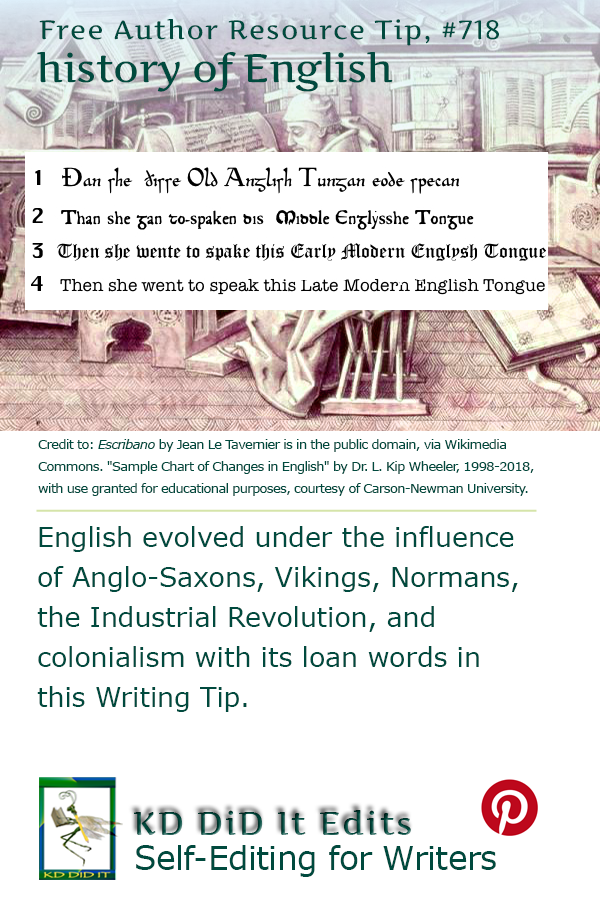In the History of the Word in the Word Confusion posts, I’ve been noting whether a word was Old English, Middle English, or Modern English, but I haven’t noted what time periods those “eras” cover. An important consideration if you’re writing an historical novel and need to pay attention . . . ahem . . . to words that were in vogue or not.
Of course, you must determine for yourself how much flavor you want to give your story.
Writing is . . .
. . . a lot of work . . . yeah, you already know that one, lol. What the posts on “Writing” are intended to do is explore the various mechanics of writing from plots to points-of-view to structure to character development to genres to voice to target audience to book types to character or story arcs to back stories to plot devices to themes to diction to copyright to flashforwards to flashbacks to framing the story or devices to memes to tropes to pace to perspective to settings to show versus tell to social context to continuity to storyboards to style to language to style sheets to syntax to tone to tropes and more . . .
It’s an evolving conversation, and sometimes I run across an example that helps explain better or another “also known as”. Heck, there’s always a better way to explain it, so if it makes quicker and/or better sense, I would appreciate suggestions and comments from anyone on some aspect of writing with which you struggle or on which you can contribute more understanding.
If you found this post on “When is Old, Middle, and Modern English?” interesting, consider subscribing to KD Did It, if you’d like to track this post for future updates.
| History of English | |||
| Part of Writing: Language | |||
| Definition: The English language has evolved over time — and continues to evolve. It doesn’t make much different to many writers, but if you write historically, it will make a big difference — I never want to read that a Regency character is talking about “dimes”. | |||
| Old English (OE) | Definition: Old English is commonly referred to as Anglo-Saxon with a largely Germanic vocabulary. Spanning AD 600 to 1100/1150, there were four distinct dialects of Old English: Northumbrian, Mercian, Kentish, and West-Saxon.
With the Norman Conquest in 1066, Old English began to die out, although written Old English continued until around 1150, evolving into Middle English. A.k.a. Anglo-Saxon |
||
|
Return to top or post contents |
Old English can also be divided into three periods:
|
||
| Middle English (ME) | Definition:Spanning 1100/1150–1450/1500, roughly following the High to the Late Middle Ages, Middle English, the ancestor of Modern English, evolved from Old English in 1066 when the Normans brought Anglo-Norman, a dialect of Old French.
The Conquest brought thousands of new words from Latin and predominantly from the French, as those were the sounds with which the Normans were most familiar — they were the primary and most predominate educated people who could read and write. Credit to: Crystal, 41, 61–66, 79). |
||
|
Return to top or post contents |
Middle English is usually divided into three periods:
|
||
| Modern English | Definition: Beginning around 1450, the Renaissance saw the revival of classical scholarship, and “writers introduced thousands of obscure classical words into English”, a.k.a., “inkhorn words because they took a lot of ink to write”, LOL, with Latin a very strong influence closely followed by Greek — people really needed to know their Latin.
Credit to: Crystal, 69–70 |
||
Modern English is broken up into three periods:
|
|||
C’mon, get it out of your system, bitch, whine, moan . . . which words are your pet peeves? Also, please note that I try to be as accurate as I can, but mistakes happen or I miss something. Email me if you find errors, so I can fix them . . . and we’ll all benefit!
Satisfy your curiosity about other Writing Ideas and Resources on its homepage or more generally explore the index of self-editing posts. You may also want to explore Book Layout & Formatting Ideas, Formatting Tips, Grammar Explanations, Linguistics, Publishing Tips, the Properly Punctuated, and Working Your Website.
Resources for History of English
Some of these links may be affiliate links, and I will earn a small percentage, if you should buy it. It does not affect the price you pay.
Crystal, David. Spell It Out: The Curious, Enthralling, and Extraordinary Story of English Spelling. New York: St. Martin’s Press: 2013. <https://amzn.to/3jWiYKO>. Ebook.
The Editors of Encyclopædia Britannica.
Mastin, Luke. “Late Modern English (c. 1800 – Present)” courtesy of The History of English.
⸻. “Old English (c. 500 – c. 1100).”
Sites of Interest
100 most frequent Middle English words.” Stanislaus State.
Gelderen, Elly van. “Sample Texts.”
“Grammar in Early Modern English.” Oxford English Dictionary with a slew of other posts to explore.
Jebson, Tony. “The Origins of Old English.” The History of English.
Lingojam has an English to Shakespearean generator in which you can type up an English sentence and it generates its equivalent in Early Modern English.
Pinterest Photo Credits
Escribano by Jean Le Tavernier was resized with the levels and hue adjusted, saturated, and a transparency applied. It is in the public domain, via Wikimedia Commons. “Sample Chart of Changes in English” by Dr L. Kip Wheeler, 1998-2018, with use granted for educational purposes, courtesy of Carson-Newman University.
Revised as of 23 Apr 2024
By: Kathy Davie

